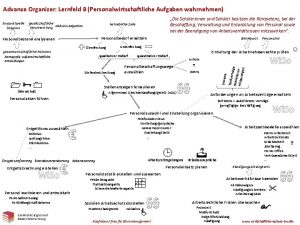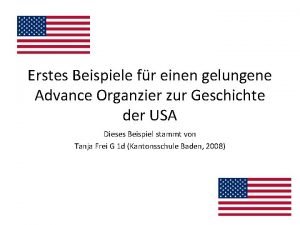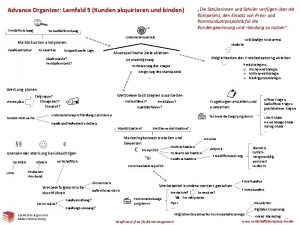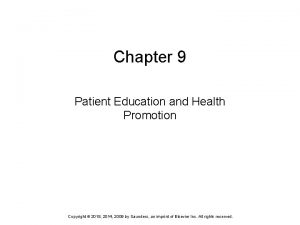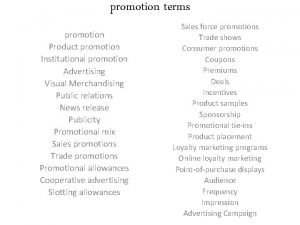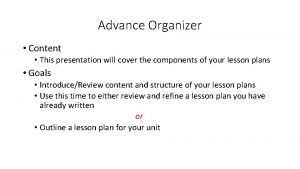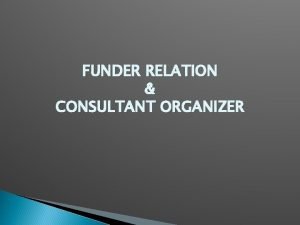Workplace Health Promotion Chapter 4 Content Advance organizer


















- Slides: 18

Workplace Health Promotion Chapter 4.

Content • Advance organizer • Definitions • Background to workplace health promotion • The European Reference Model for Workplace Health Promotion

Case study – The FAG Hospital –Introduction in the case-study –Situation description –Staff data –Workplace characteristics

An Ecological Model of Health

Ottawa Charter for Health Promotion • The Charter for Health Promotion which was adopted in Ottawa in 1986 identified five health promotion action areas: 1. build Healthy Public Policy, 2. create supportive environments, 3. develop personal skills, 4. strengthen community action, 5. reorient health services

Luxemburg Declaration document (2005) Definition of WHP Workplace health promotion (WHP) is the combined efforts of employers, employees and society to improve the health and wellbeing of people at work. 1. This is achieved through a combination of: 2. improving the work organization and working environment; 3. promoting the participation of workers in the whole process of WHP; 4. enabling healthy choices, 5. encouraging personal development

Health promoting organizations have major advantages • Development and better quality of human resources • Financial savings • Improved internal social relations • Creation of a positive social image • Support for marketing activities

Implementing WHP Programs - accomplished with simple, low-cost strategies • Provide incentives for participation. • Establish a wellness informational campaign. • Schedule wellness seminars on diabetes, nutrition, physical fitness and cholesterol, etc. • Establish initiatives such as fitness, sleep diary, tobacco use cessation and injury prevention. • Provide onsite chair massages or simple stretching exercises to do at the desk. • Change vending machine options to offer healthier, low-fat snacks and drinks. • Actively promote employee participation in all Workplace Health Promotion Program

Implementation, WHP characteristics • It is health linked activity, which is NOT legal obligation • It is voluntary activity for employers and employees • It is about workplace health activity, based on – Risks – Needs – Preferences

The European Reference Model for Workplace Health Promotion The generic environment for WHP

The European Reference Model for WHP - Scope • Promote good practices of WHP, in according with the European reference model • It is an action model for practitioners • To inform practitioners about field policies

The European Reference Model for Workplace Health Promotion Main Elements: The process Actors and actions Enabling and constraining factors Outcomes

General model of workplace health promotion

The principal actors and actions in the WHP implementation process Internal to the enterprise Actors Workers Occupational health staff Human resource management Health and safety representatives Line management Trade Union representatives Works Councils Training departments Actions Marketing health promotion Setting up structures Assessing needs Developing a plan Implementing the plan Evaluating the initiative Consolidating the initiative External to the enterprise Actors Insurers WHP suppliers Multiplier organisations Public health agencies Health promotion agencies Occupational health services Actions Marketing WHP Providing WHP services Making policy on WHP Supporting WHP Funding WHP

Enabling and constraining factors for WHP Enabling factors Internal factors Health policy Health budget Occupational health service Broad absenteeism policy Quality management practices Trained personnel Participatory practices Good industrial relations atmosphere Progressive training policies Older workers External factors Integrated services Multiplier/intermediary organisations National/regional WHP policy Active involvement of Insurers Constraining factors Internal factors Negative industrial relations atmosphere Small size of enterprise Narrowly defined Occupational Health Services WHP Policy vacuum Ill defined responsibilities for WHP Low motivation for WHP Lack of comprehensive illness absenteeism records Younger workers Newer enterprises External factors Narrowly defined Occupational Health Services WHP Policy vacuum Ill defined responsibilities for WHP Lack of proven methodologies for WHP Lack of trained personnel

Outcomes of WHP implementation Direct effects Health benefits Improved health awareness Improved health status Improved health related behaviours Improved mental wellbeing Reduced psychosocial stress at work Improved fitness Improved social support at work Indirect effects Health benefits Reduced accident rates Improved occupational health Improved general health Organisational benefits Reduced health related absenteeism Return on investment Organisational benefits Improved industrial relations atmosphere Improved corporate image Improved productivity Improved product/service quality Improved workforce skill levels Improved morale

Conclusions • WHP in Europe has been a relatively recent phenomenon, but in its short history it has developed a strong record of practice and achievement. • It faces difficulties of acceptance because it does not have a statutory basis, but in many countries it is seen as a significant part of workplace health management.

WHP Program Pictures, Romania
 Skimming advance organizer
Skimming advance organizer Cues questions and advance organizers
Cues questions and advance organizers Advance organizers examples
Advance organizers examples Advance organizer
Advance organizer Advance organizer
Advance organizer Advance organizer unterricht
Advance organizer unterricht Advance organizer beispiele
Advance organizer beispiele Cues and questions
Cues and questions Advance organizer biologie
Advance organizer biologie Kunden akquirieren und binden
Kunden akquirieren und binden Correlative subsumption example
Correlative subsumption example Ausubel
Ausubel Difference between health education and propaganda
Difference between health education and propaganda Health maintenance and promotion
Health maintenance and promotion Ucf health sciences health promotion track
Ucf health sciences health promotion track Workplace web content management
Workplace web content management Chapter 9 patient education and health promotion
Chapter 9 patient education and health promotion Carrier content vs real content
Carrier content vs real content Static content vs dynamic content
Static content vs dynamic content



